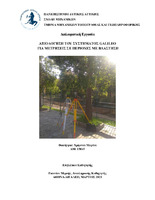| dc.contributor.advisor | Gianniou, Michail | |
| dc.contributor.author | Χρήστου, Μαρίνα | |
| dc.date.accessioned | 2021-03-06T12:29:11Z | |
| dc.date.available | 2021-03-06T12:29:11Z | |
| dc.date.issued | 2021-03-04 | |
| dc.identifier.uri | https://polynoe.lib.uniwa.gr/xmlui/handle/11400/291 | |
| dc.identifier.uri | http://dx.doi.org/10.26265/polynoe-142 | |
| dc.description.abstract | Η παρούσα εργασία έχει ως αντικείμενο το δορυφορικό Ευρωπαϊκό Σύστημα Galileo. Πραγματοποιήθηκε μελέτη και ανάλυση των χαρακτηριστικών του συστήματος Galileo καθώς και των θετικών επιπτώσεων που είναι ικανό να προσφέρει στην τοπογραφία με έμφαση σε μετρήσεις κάτω από φυλλώματα δέντρων σε σύγκριση με το αμερικανικό σύστημα GPS. | el |
| dc.format.extent | 143 | el |
| dc.language.iso | el | el |
| dc.publisher | Πανεπιστήμιο Δυτικής Αττικής | el |
| dc.rights | Αναφορά Δημιουργού - Μη Εμπορική Χρήση - Παρόμοια Διανομή 4.0 Διεθνές | * |
| dc.rights | Attribution-NonCommercial-NoDerivatives 4.0 Διεθνές | * |
| dc.rights.uri | http://creativecommons.org/licenses/by-nc-nd/4.0/ | * |
| dc.subject | Παγκόσμια Δορυφορικά Συστήματα Εντοπισμού GNSS | el |
| dc.subject | Galileo | el |
| dc.subject | Μετρήσεις κάτω από φυλλώματα | el |
| dc.title | Αξιολόγηση του συστήματος Galileo για μετρήσεις σε περιοχές με βλάστηση | el |
| dc.title.alternative | Εvaluation of the Galileo system for measurements under canopies | el |
| dc.type | Διπλωματική εργασία | el |
| dc.contributor.committee | Gianniou, Michail | |
| dc.contributor.committee | Παγούνης, Βασίλειος | |
| dc.contributor.committee | Ανδριτσάνος, Βασίλειος | |
| dc.contributor.faculty | Σχολή Μηχανικών | el |
| dc.contributor.department | Τμήμα Μηχανικών Τοπογραφίας και Γεωπληροφορικής | el |
| dc.description.abstracttranslated | The present Diploma Thesis aims to examine the European Union Global Navigation Satellite System (GNSS) "Galileo". The Thesis focuses on the advanced characteristics of Galileo for measurements under canopies.The performance of Galileo in measurements under canopies is examined in comparison to GPS and the enhanced characteristics of its signals (in particular E5) are outlined. | el |


